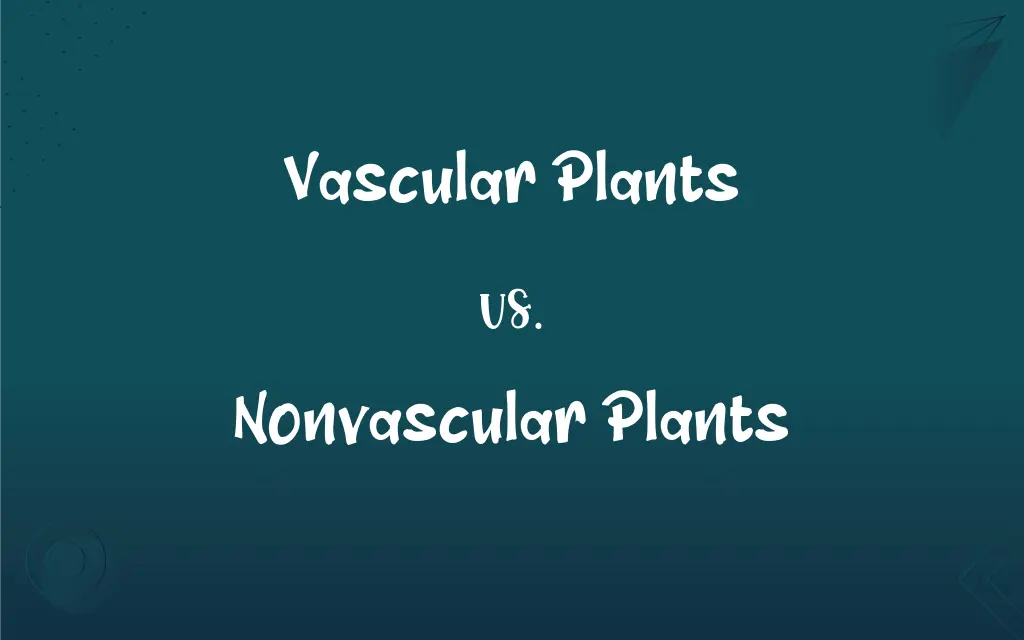Vascular Plants vs. Nonvascular Plants: What's the Difference?
Edited by Janet White || By Harlon Moss || Updated on October 17, 2023
Vascular plants have specialized systems (xylem and phloem) for water and nutrient transport. Nonvascular plants lack these systems, relying on diffusion.

Key Differences
Vascular plants are a vast group within the plant kingdom distinguished by the presence of specialized conductive tissue systems, namely xylem and phloem. These tissues facilitate the transport of water, nutrients, and food throughout the plant. On the other hand, nonvascular plants do not possess such intricate conductive systems and largely depend on the surrounding environment and simple diffusion to obtain water and nutrients.
The presence of vascular tissues in vascular plants not only aids in resource transportation but also provides structural support, allowing them to achieve greater heights and sizes. Conversely, nonvascular plants typically remain close to the ground, with their structures sprawling outwards rather than upwards due to the absence of strong support tissues.
Reproduction in vascular plants often involves seeds, either as gymnosperms (non-flowering) or angiosperms (flowering). These seeds allow for efficient dispersal and germination under suitable conditions. In contrast, nonvascular plants, like mosses and liverworts, reproduce through spores, requiring a moist environment for successful reproduction.
Habitat adaptation varies between the two groups. Vascular plants, with their advanced transport systems, can thrive in diverse habitats, from arid deserts to dense forests. In contrast, nonvascular plants predominantly occupy damp, shaded environments where they can absorb water and nutrients directly from their surroundings.
Evolutionarily, nonvascular plants are considered primitive compared to vascular plants. The latter's advanced transport systems represent an evolutionary adaptation that enables them to colonize a broader range of habitats and achieve greater structural complexity.
ADVERTISEMENT
Comparison Chart
Conductive Tissues
Present (xylem and phloem)
Absent
Structural Support
Strong (can grow tall)
Limited (usually low-growing)
Reproduction
Seeds (either from flowers or cones)
Spores
Typical Habitats
Diverse (from deserts to rainforests)
Moist, shaded environments
Evolutionary Position
More advanced (due to specialized systems)
Primitive (lacking specialized systems)
ADVERTISEMENT
Vascular Plants and Nonvascular Plants Definitions
Vascular Plants
Plants with conductive tissues for nutrient and water transport.
Ferns and pines are examples of vascular plants.
Nonvascular Plants
Plants lacking xylem and phloem.
Due to their simplicity, nonvascular plants have specific habitat needs.
Vascular Plants
Seed-producing plants with distinct transport systems.
Due to their vascular systems, vascular plants can survive in challenging environments.
Nonvascular Plants
Primitive plants reproducing via spores.
Nonvascular plants require moisture for successful reproduction.
Vascular Plants
Advanced plants capable of growing in various habitats.
Vascular plants have colonized both deserts and wetlands.
Nonvascular Plants
Ground-hugging plants relying on direct absorption.
Nonvascular plants often form lush carpets on forest floors.
Vascular Plants
Plants featuring xylem and phloem for internal circulation.
Trees, being vascular plants, can reach impressive heights.
Nonvascular Plants
Plants without specialized transport tissues.
Mosses, as nonvascular plants, thrive in damp areas.
Vascular Plants
Organisms with structural support and specialized tissues.
Vascular plants showcase nature's intricacy with their specialized systems.
Nonvascular Plants
Simple plants without internal circulation systems.
The beauty of nonvascular plants lies in their adaptability to wet conditions.
FAQs
Why do nonvascular plants need a moist environment?
Nonvascular plants rely on direct absorption and diffusion, needing moisture for nutrient uptake and reproduction.
Do all vascular plants produce flowers?
No, only angiosperms among vascular plants produce flowers; gymnosperms produce cones.
Are ferns vascular or nonvascular?
Ferns are vascular plants.
What tissues do vascular plants possess for transport?
Vascular plants have xylem and phloem for transport.
How do nonvascular plants obtain water?
Nonvascular plants absorb water directly from their surroundings.
Can vascular plants grow tall?
Yes, vascular plants can achieve considerable heights due to their structural support.
What's the evolutionary significance of vascular tissues?
Vascular tissues allowed plants to colonize diverse habitats and grow taller.
Which is more ancient, vascular or nonvascular plants?
Nonvascular plants are evolutionarily more ancient.
Can nonvascular plants live on rocks?
Yes, many nonvascular plants, like mosses, can grow on rocks if there's enough moisture.
Do nonvascular plants have roots?
Nonvascular plants have rhizoids, which are simpler than roots.
Where can you typically find nonvascular plants?
Nonvascular plants are often found in damp, shaded areas.
Do vascular plants have seeds?
Yes, vascular plants reproduce through seeds.
Are there any advantages to being a nonvascular plant?
Being nonvascular allows these plants to colonize habitats with direct water access, places many vascular plants can't thrive.
Which group is larger, vascular or nonvascular plants?
Vascular plants make up a larger and more diverse group than nonvascular plants.
Do vascular plants depend on water for fertilization?
While some do, many vascular plants have evolved mechanisms to fertilize without direct water dependence.
How do nonvascular plants support themselves without vascular tissues?
Nonvascular plants stay low to the ground, using surrounding moisture and a simple structure for support.
Why are vascular systems significant in plant evolution?
They allowed plants to grow taller, live in varied habitats, and develop diverse reproductive strategies.
What is the main method of reproduction in vascular plants?
Vascular plants mainly reproduce through seeds.
Do nonvascular plants have leaves?
Nonvascular plants have simple leaf-like structures, but they aren't true leaves like in vascular plants.
Can nonvascular plants survive in dry conditions?
Nonvascular plants typically need moist environments to thrive.
About Author
Written by
Harlon MossHarlon is a seasoned quality moderator and accomplished content writer for Difference Wiki. An alumnus of the prestigious University of California, he earned his degree in Computer Science. Leveraging his academic background, Harlon brings a meticulous and informed perspective to his work, ensuring content accuracy and excellence.
Edited by
Janet WhiteJanet White has been an esteemed writer and blogger for Difference Wiki. Holding a Master's degree in Science and Medical Journalism from the prestigious Boston University, she has consistently demonstrated her expertise and passion for her field. When she's not immersed in her work, Janet relishes her time exercising, delving into a good book, and cherishing moments with friends and family.































































